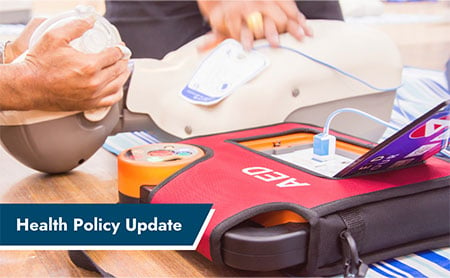State Policies Promote the Importance of Defibrillators and CPR
February 16, 2023 | Lana McKinney
 Heart disease remains the leading cause of death in the United States for men, women, and most ethnic groups—even during the COVID-19 pandemic. And while overall rates of death from heart disease have declined over the past couple of decades, non-Hispanic Black persons are more likely to die from heart disease than other racial and ethnic groups. Additionally, more than 400,000 cardiac arrests occur annually outside a hospital setting.
Heart disease remains the leading cause of death in the United States for men, women, and most ethnic groups—even during the COVID-19 pandemic. And while overall rates of death from heart disease have declined over the past couple of decades, non-Hispanic Black persons are more likely to die from heart disease than other racial and ethnic groups. Additionally, more than 400,000 cardiac arrests occur annually outside a hospital setting.
CDC recently revised its Best Practices for Health Disease and Stroke, highlighting strategies to improve cardio- and cerebrovascular health. One goal is to increase public access to automated external defibrillators (AEDs). Early use of AEDs by bystanders or emergency medical technicians during out-of-hospital cardiac arrest has been shown to improve survival rates to greater than 50%; those rates can triple if CPR is performed within the first few minutes of cardiac arrest.
Policies to develop and maintain public access to AEDs and CPR training are crucial. Across the country, state legislatures are enacting or considering legislation related to AEDs and CPR that enhance bystander response to cardiac events and improve the chance of survival of persons who experience cardiac arrest. As policymakers develop and adopt these measures, they should also consider health equity and data implications.
Legislative Actions to Increase AED Access and CPR Training
So far in 2023, several states have introduced legislation to require the placement of AEDs in certain publicly accessible locations, including highway rest areas (WV HB 3038), county government buildings (MA HD 1842), all public safety vehicles (MA SD 2342), hotels (NJ A 5105), urgent care and retail health clinics (NJ S 1768), and health clubs (MA HD 2574). Additionally, at least four states—Massachusetts (HD 774), Mississippi (HB 203), Missouri (HB 426), and New York (S 1698)—have introduced legislation requiring AEDs in schools this year. New York also proclaimed a CPR-AED Awareness Week.
Although relatively uncommon, an estimated 2,000 children each year die from sudden cardiac arrest. As of 2021, 39 states and Washington D.C. required CPR training for high school students. In 2023, at least four states have introduced bills to expand CPR certification and AEDs training. These include a bill to further expand high school education on CPR and AEDs (OK SB 236), and a bill that requires every public and charter school in the state to (1) have at least one employee with a valid CPR certification and (2) to provide annual CPR training for all high school personnel and students (AZ HB 2421).
In Colorado, SB 23-023 encourages each public school to provide CPR and AED instruction to students in grades nine through 12. West Virginia introduced SB 469 to establish a revolving loan fund that provides funding for CPR instruction to high school students. Meanwhile, California legislators are considering
AB 245 to update school-based CPR and first aid training by adding a requirement to rehearse the appropriate responses to the signs and symptoms of concussions, heat illness, and cardiac arrest.
Challenges of Equity in CPR and AED training
As the evidence base about the impact AEDs and CPR have as lifesaving measures for cardiac arrest continues to build, the equitable distribution of AEDs equipment, its maintenance, and training for AEDs must also be considered.
Strategies that optimize the location of public access AEDs based on the risk of cardiac arrest associated with the site can help improve accessibility. Such registries can inform the public and emergency dispatchers of the location of publicly accessible AEDs to facilitate use during an emergency. Registries may also contribute to improving AED readiness by informing owners and managers when batteries and pads need replacing.
In 2018, CDC issued a report providing evidence about the training of responders, and the placement and maintenance of AEDs. While jurisdictions recognize the importance of AED devices, their affordability is a continuing concern.
Further Considerations
Understanding how to best measure and influence cardiac event outcomes and their contributing factors is critical to informing policy decisions. There are several ongoing challenges to understanding the national epidemiology of cardiac arrest, including the incidence and outcomes of out-of-hospital cardiac arrest and the reporting of such events. Additional knowledge is needed about out-of-hospital cardiac arrest key components such as geographic incidence, risk factors, and the impacted populations.
Valid data can advance and improve health outcomes by providing appropriate resource allocation and evidence-based service provision. Despite being one of the leading causes of death, there are currently no nationwide standards for surveillance to monitor the incidence and outcomes of cardiac arrest.
Public health officials can help policymakers by reviewing their jurisdictions’ current AED laws and by increasing awareness of the positive impact AED policies and CPR training have on responding to a cardiac arrest. Bystanders can improve the survival rate of a person who is experiencing sudden cardiac arrest with increased public access to AEDs and additional CPR training.
Overall, additional policy actions to support AED availability and CPR training will continue to improve health outcomes. It is important to continue to acknowledge American Heart Month and all the improvements policy makes to save lives.
Special thanks to ASTHO’s Erin Bayer, Senior Director of Chronic Disease Prevention and Health Improvement and Andy Baker-White, Senior Director of State Health Policy, and Erin Gabert of the American Heart Association for their contributions to this blog post.